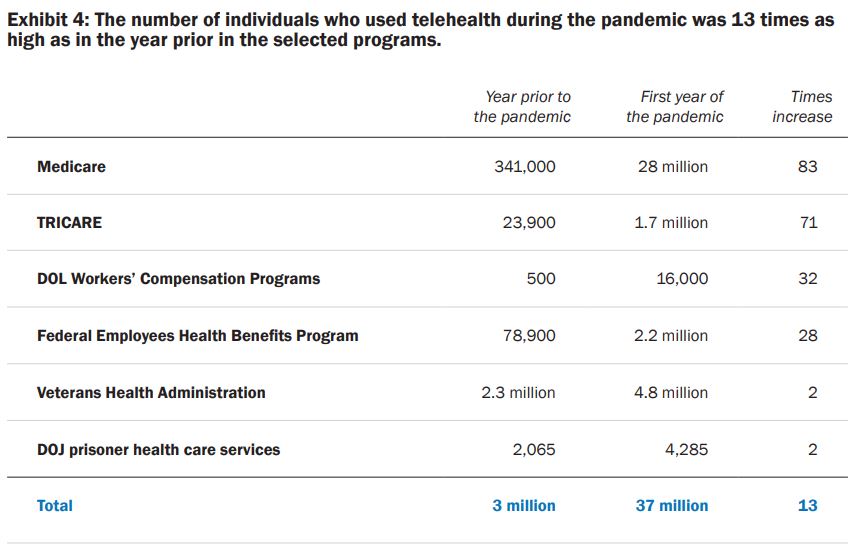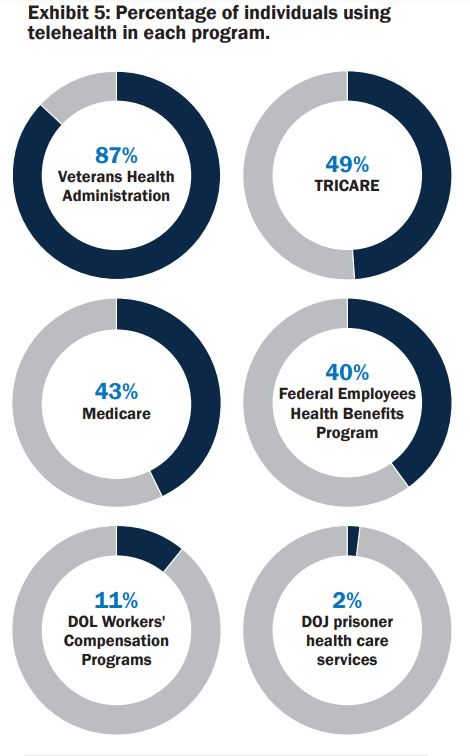
Click to Enlarge:
Notes: The total represents the aggregated number of individuals who used telehealth in each program. Individuals who received
telehealth from more than one program may be counted multiple times. Numbers are rounded. Calculations of totals and increases were conducted on unrounded numbers. The number of individuals who used telehealth in the Veterans Health Administration includes those who used telehealth directly from VA providers; it does not include data on individuals who received telehealth from non-VA providers in the community. In addition, the numbers for the Federal Employees Health Benefits Program include data from the largest insurer, which represents approximately 68 percent of individuals enrolled in all plans. Source: Pandemic Response Accountability Committee’s (PRAC’s) Health Care Subgroup – Analysis of data from selected programs in six federal agencies, 2022.
WASHINGTON, DC — While the pandemic has resulted in an explosion in the use of telehealth among federal health agencies, it also has created opportunities for fraud and waste, according to a recent joint report from six Offices of the Inspector General (OIGs). Much of that fraud has come in the form of “upcoding,” with agencies being billed at the highest level possible and at a volume that, at first glance, seems fraudulent.
The report, created by the Pandemic Response Accountability Committee’s (PRAC’s) Health Care Subgroup, looks at the use of telehealth by VA, Medicare, TRICARE, the Federal Employees Health Benefits Program, Office of Workers’ Compensation Programs, as well as the Federal Bureau of Prisons and U.S. Marshals Service, which oversees Department of Justice prisoner health services.
Three of the OIGs (HHS, Office of Personnel Management and Department of Labor) identified providers who billed for the highest level of telehealth services a large percentage of the time. For example, the HHS OIG identified more than 300 Medicare providers who billed at the most expensive level, totaling approximately $5.2 million. VA’s OIG identified an increased volume of high level billing during the first year of the pandemic totaling approximately $10.7 million.
Some of the instances of fraudulent billing were more subtle. The DOL OIG discovered one provider who treated an individual twice weekly for 45-50 minutes but used an inappropriate billing code that represented 60 minutes of psychotherapy. The record showed that this provider used that 60-minute billing code for most of his cases.
Several agencies also identified providers who regularly made duplicate billing claims. According to the VA OIG, the department paid approximately $1.5 million for about 14,000 possible duplicate telehealth claims involving about 1,900 providers. The HHS OIG identified 138 providers who repeatedly billed both Medicare fee-for-service and a Medicare Advantage plan for the same telehealth service.
Three OIGs (HHS, OPM, and VA) identified providers who billed for a high average number of hours per visit or per day (more than 18 hours). VA reportedly paid $578,000 for claims associated with high usage days from March 2020 through February 2021.

Click to Enlarge: Notes: The number of individuals who used telehealth in the Veterans Health Administration includes those who used telehealth directly from VA providers. In addition, the numbers for the Federal Employees Health Benefits Program include
data from the largest insurer, which represents approximately 68 percent of individuals enrolled in all plans. Source: Pandemic Response Accountability Committee’s (PRAC’s) Health Care Subgroup – Analysis of data from selected programs in six federal agencies, 2022.
The watchdog agencies also found instances of clinicians billing for services that were ineligible for payment as a telehealth service. For example, the OPM OIG identified one provider who billed for wound debridement as a telehealth service. The DOL OIG found a provider who billed for acupuncture. HHS and DoD also identified providers who billed for both telehealth services and facility fees, indicating that the patient and provider were in the same location at the time of the telehealth visit.
There is also concern among the OIGs about telehealth fraud instigated by laboratory owners or medical equipment providers who engaged in conspiracies to fraudulently bill the government for unnecessary goods or services.
“In the last few years, several large healthcare fraud investigations have involved telemarketing schemes, often referred to as telefraud,” the report states. “In one example, a laboratory owner paid kickbacks to an individual to arrange for telehealth providers to order genetic testing on behalf of Medicare beneficiaries. This individual then gave Medicare beneficiary information to these providers, which they could use to bill for telehealth services. In some similar cases, the sham telehealth visits were billed to Medicare. In several other cases, the providers did not bill for sham telehealth visits. Instead, the perpetrators billed fraudulently only for other items or services, like durable medical equipment or genetic tests.”
One concern that applies to all of the agencies is that there is a general lack of data on quality of care when it comes to telehealth services. Most of the departments have limited information on the impact of telehealth on patients. Even in VA, where there has been somewhat more study into telehealth, the OIG found a need for more ongoing studies to evaluate the impact of telehealth during the pandemic.
“Despite limited information, the OIGs identified some specific concerns related to the impact of telehealth on quality of care,” the report notes. “For example, one of TRICARE’s contractors identified 89 potential quality issues related to telehealth during the first year of the pandemic, up from seven issues the year before.”
While all of the programs have some type of safeguards in place to ensure the integrity of their telehealth services, all of them could be strengthened, the report concluded. Additional safeguards recommended by the OIGs include: additional telehealth service monitoring; additional billing controls; education of providers and the public about telehealth; collecting more data on telehealth services; and a review of the impact of telehealth services on quality of care.

